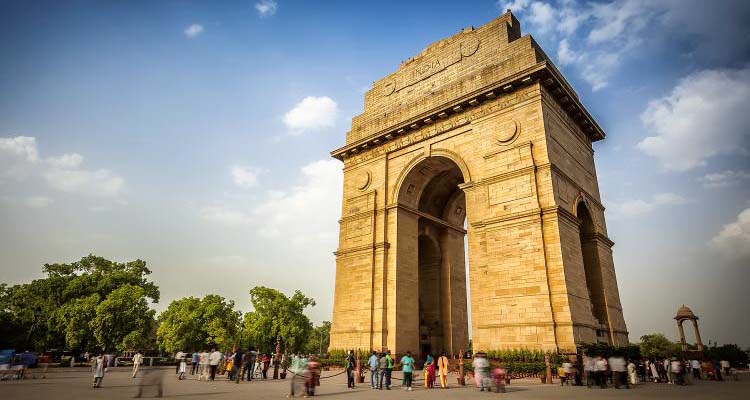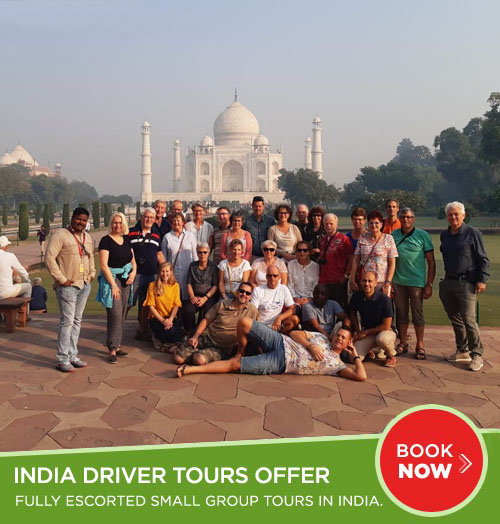Delhi
Delhi is India’s capital city and the home of executive, legislative, and judiciary branches of the Government of India. Delhi is a large metropolis with strengths in arts, commerce, education, entertainment, fashion, finance, healthcare, media, professional services, research and development, tourism and transport all contributing to its prominence.

General Information
Area 1483 sq. kms
Altitude: 239 mts
Climate:
Delhi’s has an extreme climate. It is very hot in summer (April – July) and cold in winter (December – January). The average temperature can vary from 25oC to 45oC during the summer and 22oC to 5oC during the winter.
In summer adequate precautions need to be taken, to avoid the intense heat, such as wearing light cotton clothing, wearing a hat or sunshade while going outdoors and drinking plenty of liquids. In winter, wearing warm or woolen clothing will protect you from the cold.
Best Season: September to March
History of Delhi
Delhi, the capital of India has a strong historical background. It was ruled by some of the most powerful emperors in Indian history.
The history of the city is as old as the epic Mahabharata. The town was known as Indraprastha, where Pandavas used to live. In due course eight more cities came alive adjacent to Indraprastha: Lal Kot, Siri, Dinpanah, Quila Rai Pithora, Ferozabad, Jahanpanah, Tughlakabad and Shahjahanabad.
Delhi has been a witness to the political turmoil for over five centuries. It was ruled by the Mughals in succession to Khiljis and Tughlaqs.
In 1192 the legions of the Afghan warrior Muhammad of Ghori captured the Rajput town, and the Delhi Sultanate was established (1206). The invasion of Delhi by Timur in 1398 put an end to the sultanate; the Lodis, last of the Delhi sultans, gave way to Babur, who, after the battle of Panipat in 1526, founded the Mughal Empire. The early Mughal emperors favoured Agra as their capital, and Delhi became their permanent seat only after Shah Jahan built (1638) the walls of Old Delhi.
From Hindu Kings to Muslim Sultans, the reins of the city kept shifting from one ruler to another. The soils of the city smell of blood, sacrifices and love for the nation. The old ‘Havelis’ and edifices from the past stand silent but their silence also speaks volumes for their owners and people who lived here centuries back.
In the year 1803 AD, the city came under the British rule. In 1911, British shifted their capital from Calcutta to Delhi. It again became the center of all the governing activities. But, the city has the reputation of over throwing the occupants of its throne. It included the British and the current political parties that have had the honour of leading free India.
After independence in 1947, New Delhi was officially declared as the Capital of India.
List of tourist attractions in Delhi
Purana Quila
The Purana Quila (Old Fort) is a very good example of Mughal military architecture.
Chandni Chowk
Chandni Chowk, a main marketplace in Delhi, keeps alive the city’s living legacy of Shahjahanabad.
Qutb Minar
The Qutub Minar is located in Qutb complex, Mehrauli in South Delhi. It was built by Qutub-ud-din Aibak of the Slave Dynasty, founder of the Delhi Sultanate, started construction of the Qutub Minar’s first storey around 1192. In 1220, Aibak’s successor and son-in-law Iltutmish completed a further three storeys. In 1369, a lightning strike destroyed the top storey. Firoz Shah Tughlaq replaced the damaged storey, and added one more.. It is a fluted red sandstone tower, which tapers up to a height of 72.5 meters and is covered with intricate carvings and verses from the Qur’an.
Akshardham Temple it is the third largest Hindu temple in the world. It was built in 2005. In the sprawling 100-acre (0.40 km2) land rests an intricately carved monument, high-technology exhibitions, a musical fountain, a food court and gardens.[1]
Laxminarayan Temple
The Laxminarayan Temple is built in honour of Lakshmi (Hindu goddess of wealth), and her consort Narayana (Vishnu, Preserver in the Trimurti) by B. R. Birla from 1933 and 1939, when it was inaugurated by Mahatma Gandhi. The side temples are dedicated to Shiva, Krishna and Buddha.
The temple spread over 7.5 acres, is adorned with many shrines, fountains, and a large garden, and also houses Geeta Bhawan for discources. The temple is one of the major attractions of Delhi and attracts thousands of devotees on the Hindu festivals of Janmashtami and Holi.
ISKCON Temple
ISKCON Temple also popularly called as the Hare Krishna temple is a famous Vaishnava temple with deities of Sri Radha Krishna. Located in South Delhi, the construction of the temple began in 1991 and was completed in 1998 under the planning of internationally renowned architect Achyut Kanvinde.
The temple primarily built with red stone is recognized for its unique architecture which blends the traditional Vedic with contemporary style. The complex also houses a one of a kind in the country Robtic show which explains the message of Bhagavad Gita. Another highlight of the temple is beautifully drawn paintings of the Lord done by the foreign devotees. Apart from these, the temple acts as study base for those wish to study the Vedic scriptures, Yoga and provides facility for practicing Bhakti Yoga as given by Srila Prabhupada. The temple also serves the devotees pure vegetarian food at its ‘Govindas’ restaurant. The temple is easy to approach as it well connected by buses and Metro trains.
Jama Masjid
The Masjid-i-Jahan Numa, commonly known as Jama Masjid, is the principal mosque of Old Delhi. Commissioned by the Mughal Emperor Shah Jahan and completed in the year 1656, it is one of the largest and best known mosques in India.It can accommodate around 25,000 people at once.
Lotus Temple
The Lotus Temple is an exceptionally beautiful structure, created by the Bahá’í House of Worship, situated in South Delhi and looks like a white lotus. It was built by the Bahá’í community.
Lal Mandir
Shri Digambar Jain Lal Mandir is the oldest and best-known Jain temple in Delhi originally built in 1658. This temple is located just opposite the massive Red Fort at the intersection of Netaji Subhas Marg and Chandni Chowk. The Temple is an impressive structure made up red stone giving the name Lal Mandir.
Jantar Mantar
The Jantar Mantar consists of 13 architectural astronomy instruments, built by Maharaja Jai Singh II.
Raj Ghat
On the banks of the Yamuna River, which flows past Delhi, there is Raj Ghat, the final resting place of Mahatma Gandhi, the father of the nation. It has become an essential point of call for all visiting dignitaries. Two museums dedicated to Gandhi are situated nearby.
The India Gate is one of the most famous monuments in Delhi. Built in the memory of more than 90,000 Indian soldiers who lost their lives during the Afghan Wars and World War I.
Humayun’s Tomb is one of Delhi’s most famous landmarks. The monument has an architectural design similar to the Taj Mahal.


